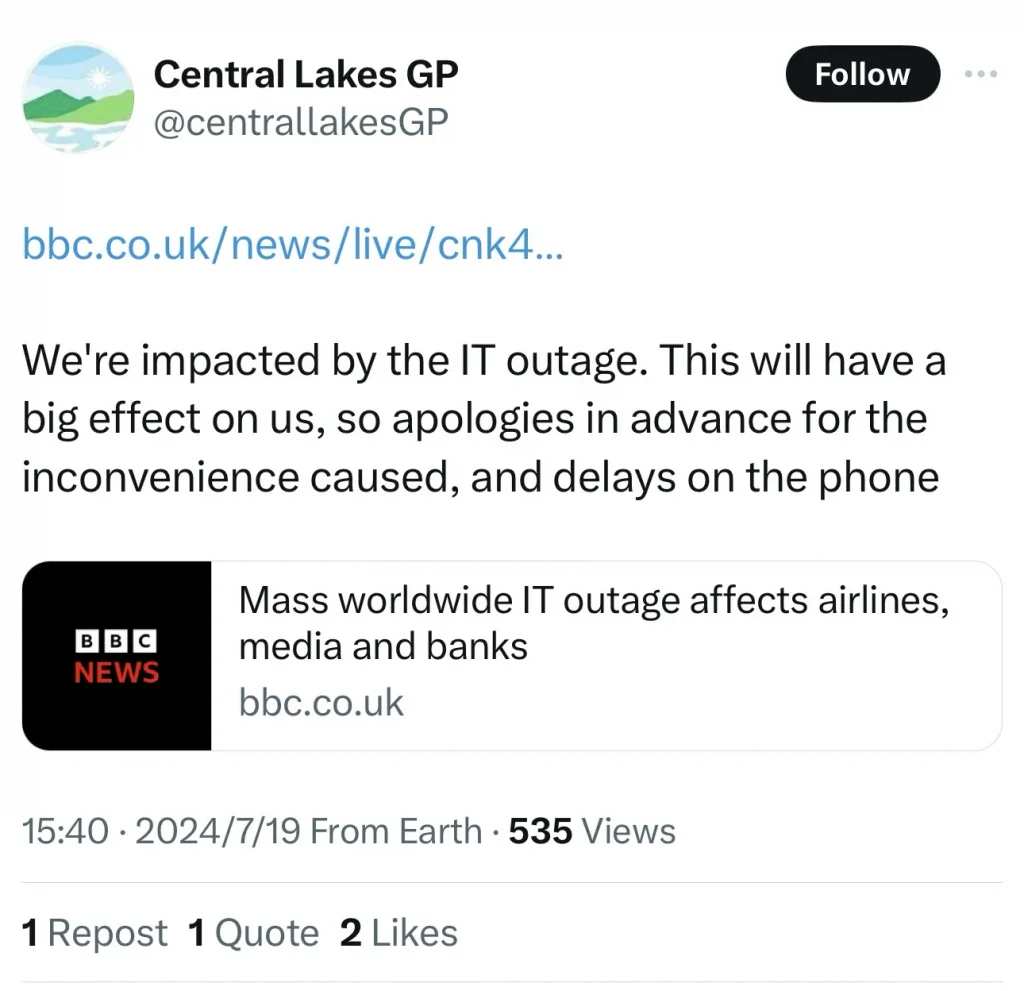- A massive IT outage has affected key sectors worldwide, including airlines, media outlets, banks, and healthcare services. The widespread disruptions have brought operations to a standstill in various parts of the globe.
- Adding to the confusion, reports have surfaced naming cybersecurity company CrowdStrike as a potential cause. CrowdStrike, known for its antivirus software, allegedly issued a software update that affected Windows devices, prompting the notorious “blue screen of death” on PCs.
OUR TAKE
It’s literally a modern-day “Butterfly Effect”. So many industries worldwide, from airlines to banks and even our daily news channels, have all stumbled over a massive IT failure. Airports in Sydney, Berlin, and Edinburgh are in chaos, with passengers as anxious as ants on a hot pan, facing flight delays and cancellations that are nothing short of a traveler’s nightmare. The banking sector is also on edge, with details still hazy, but when it comes to money matters, who isn’t nervous?
To top it off, even the media has fallen silent, with Sky News going off-air, almost cutting off our access to information. And CrowdStrike, a usually reliable company, has somehow pulled off a major blunder with the “blue screen of death,” causing widespread panic. This serves as a reminder that technology is a double-edged sword. It’s incredibly convenient, but when something goes wrong, it triggers a chain reaction with far-reaching and profound impacts. In the future, we must pay closer attention to the security of these infrastructures and not wait until problems arise to scramble for solutions.
–Miurio huang, BTW reporter
What happened
In an unprecedented event, a massive IT outage has affected key sectors worldwide, including airlines, media outlets, banks, and healthcare services. The widespread disruptions have brought operations to a standstill in various parts of the globe, causing significant inconvenience and operational chaos.
Air travel has been severely impacted. At Sydney Airport, flights were grounded as information screens went blank and airlines, including Jetstar and Virgin Australia, faced check-in and boarding issues. United Airlines also halted flights, while Delta and American Airlines issued a global ground stop, affecting thousands of passengers. Berlin Airport reported delays due to a “technical fault,” and Edinburgh Airport faced issues with departure boards, leading to missed flights. In Spain, airports switched to manual systems to continue operations amid the IT crisis. At Gatwick, barcodes are not working so security checks on boarding passes are being done manually, but security searches are operating normally.
“A third party software outage is impacting computer systems worldwide, including at United.
While we work to restore those systems, we are holding all aircraft at their departure airports. Flights already airborne are continuing to their destinations.”
United Airlines
The banking sector wasn’t spared. Several leading banks reported disruptions, although details remain scarce as institutions focus on mitigating the impact.
Media outlets experienced significant challenges. Sky News in the UK went off air, unable to broadcast live due to the outage. Australia’s Telstra Group also faced disruptions, with issues traced back to global problems affecting CrowdStrike and Microsoft. The BBC’s channel for children and teenagers, CBBC, has been down since earlier this morning, displaying a message directing viewers to BBC iPlayer. However, other BBC channels, including BBC One and CBeebies, continue to operate, while ITV and Channel 4 remain unaffected.

Healthcare services in the UK are also experiencing issues. Multiple reports indicate problems with EMIS Web, a system used by GPs to manage appointments, conduct patient consultations, and update, store, and share patient records. Clinics such as Grimethorpe Surgery in Barnsley, Church Lane Surgery in Brighouse, Central Lakes Medical Group in Ambleside, and Solihull Healthcare Partnership in the West Midlands have reported being unable to access the system, leading to disruptions in booking appointments and accessing patient records.
Adding to the confusion, reports have surfaced naming cybersecurity company CrowdStrike as a potential cause. CrowdStrike, known for its antivirus software, allegedly issued a software update that bricked Windows devices, prompting the notorious “blue screen of death” on PCs. Whether this incident is directly related to the global IT outage or merely a coincidental parallel event remains unclear
Also read: VinFast decides to postpone its EV plant in US
Also read: Google to enhance Paris Olympics broadcast with AI for US viewers
Why it’s important
This event highlights the vulnerability of modern infrastructure to IT failures, underscoring the interconnected nature of today’s digital world. The ramifications of such an outage extend far beyond immediate inconveniences, posing significant operational and financial risks.
The grounding of flights at major airports underscores the critical reliance on IT systems in aviation. The disruption not only inconvenienced passengers but also potentially compromised safety and operational efficiency. With flights halted and schedules thrown into disarray, the economic impact is significant, affecting airlines’ revenue and passengers’ travel plans.
The disruption in banking operations can have far-reaching effects, potentially leading to delays in financial transactions, impacting businesses and individuals alike. In a world where digital banking is ubiquitous, such outages can erode consumer confidence and highlight the need for robust contingency planning.
The inability of media outlets to broadcast live news demonstrates the dependence on IT infrastructure for information dissemination. In an age where real-time news is crucial, such disruptions can lead to information blackouts, affecting public awareness and response to ongoing events.
The widespread nature of the outage, affecting multiple countries and sectors simultaneously, emphasises the need for international cooperation in cybersecurity and IT management. As organisations like Microsoft work on mitigation actions, it becomes clear that global digital resilience requires coordinated efforts and shared resources.
The financial implications of such outages are vast. Delayed flights lead to additional costs for airlines and passengers, while disrupted banking services can slow economic activity. Businesses affected by payment issues, like the bakery chain Gail’s in the UK, face immediate revenue losses and potential long-term damage to their reputation.
The outage affected emergency services, such as the 911 systems in Alaska, highlighting a critical area where IT resilience is paramount. Disruptions in emergency communications can lead to life-threatening delays, stressing the importance of ensuring these systems are fail-safe.
The reports implicating CrowdStrike add another layer of complexity. If the antivirus software update indeed caused the “blue screen of death,” it underscores the risks associated with software updates and the need for rigorous testing before deployment. CrowdStrike has yet to respond to inquiries, leaving a gap in understanding the full scope and cause of the outage.

This event serves as a stark reminder of the fragility of our interconnected digital world. It calls for enhanced cybersecurity measures, better contingency planning, and greater international collaboration to safeguard against such pervasive disruptions in the future. As we rely more on technology, ensuring its resilience and robustness becomes not just a technical challenge but a societal imperative.

